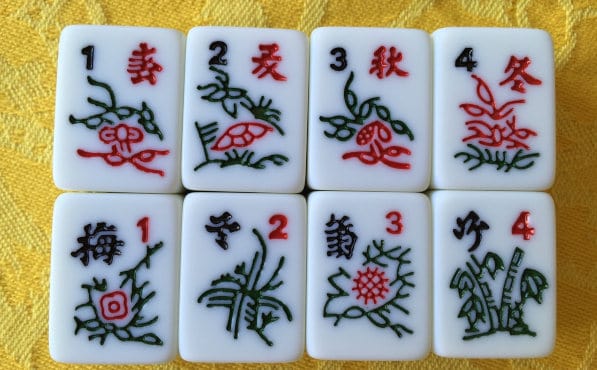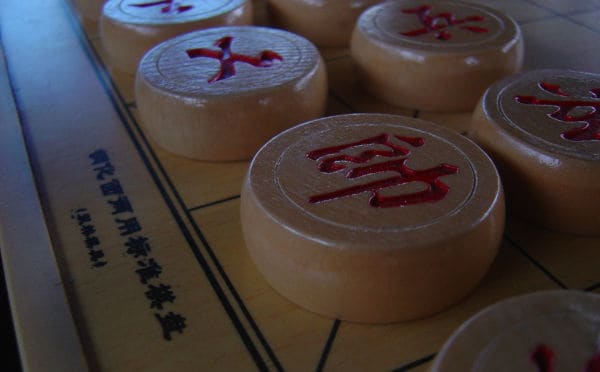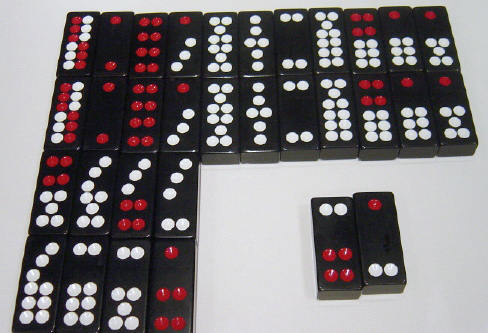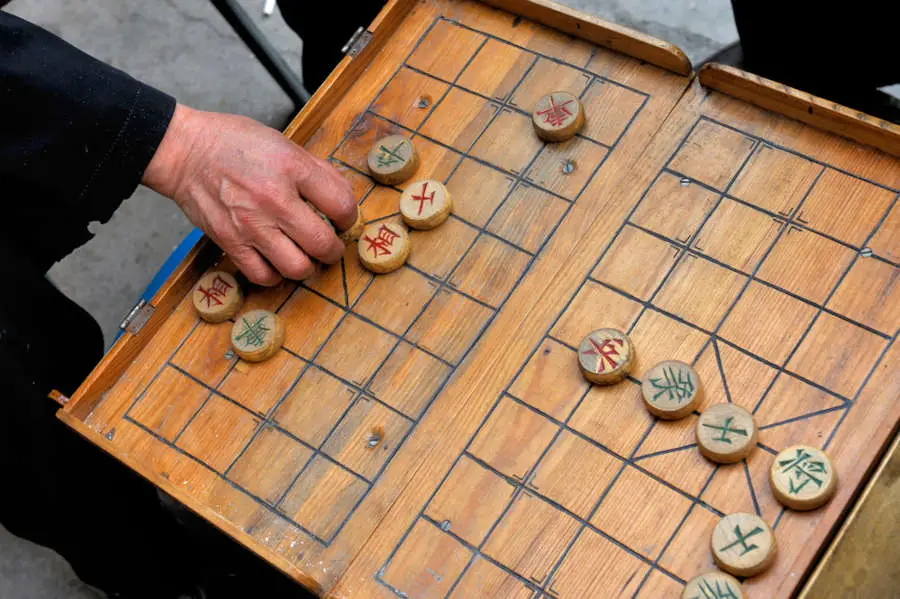China is the home of some of the oldest board and card games in the world, and some of them are still really popular both for children and adults alike. Some of them are designed with strong traditional values and even ties to the ancient eastern philosophies, so no wonder they often have elegant rules, intricate strategies, and deep playability.
Here, we will discuss five of the most popular Chinese board games we have today, some have been around for as old as thousands of years.
Let us begin.
Wei Qi (Go)

It’s a common misconception that the board game “Go” originated from Japan, which is understandable due to its wide popularity in this Land of The Rising Sun.
Arguably the world’s oldest board game, the exact origin of Go can’t be established. However, many believe that the game originated in China around 4,000 years ago, as early as 2300 BCE. The name “Go” in Japanese is derived from “igo”, which is in turn derived from the Chinese name, Wei Qi.
The earliest mention of Wei Qi is commonly agreed to be the historical narrative Zuozhuan—or Zuo’s Commentary— (Encyclopedia Britannica – Opens in a new tab), from around 4th century BCE. More famously, Wei Qi is mentioned in the Analects of Confucius. In all these ancient works, the game is mentioned as yì (弈).
In Ancient China, Wei Qi is also one of the four arts of the ancient Chinese scholar —四藝, siyi— (China Online Museum – Opens in a new tab), together with calligraphy, painting, and the guqin musical instrument. So, Go is an integral part of ancient Chinese culture.
It is believed that the game reached Korea around the 5th century CE, and Japan in around 7th century CE. It is actively played during Japan’s Nara period (710-794) and achieved its peak during the Sengoku era in the 16th century.
Basic Rules of Go/Wei Qi
The name Wei Qi can be roughly translated as “the game of surrounding” or “encircling game”, which will explain the basic objective of the game: to control more territory than your opponent, surrounding your opponent. Here is some important thing to know regarding the basic rules of Go:
- Played between two players, Black and White
- Typically played on a 19×19 board
- At the beginning of the game, the board is empty. The player with the black stones—referred to as Black’ — makes the first move.
- A move’ is made by placing a stone on an intersection on the board
- Similar to western Chess, the stone can be captured, but in Go, a stone is captured when it is “surrounded”
- After a successful capture, the player must remove one stone of their own color that has no “liberty”, called self-capture
Go is one of the hardest games to master, with intricate rules and depth.
Take a look at these awesome Chinese Go designs – Aff.link
Chinese Checkers

Chinese checkers or Chinese chequers, unlike its name, doesn’t really originate from China, and also not really a variation of checkers.
They were invented in Germany in 1892 with the original name “Stern-Halma”, and is actually developed as a variation of the American game, Halma (more about Halma in Wikipedia – Opens in a new tab), which was invented a few years earlier in 1883 or 1884.
Chinese checker is mainly characterized by its hexagram-shaped board, which can accommodate up to 6 players.
Basic Rules of Chinese Checkers
The main goal of Chinese checkers is to move all your marbles from your end to the opposite point of the star. The players can move their marbles by “hopping” over a single adjacent marble—one’s own or the opponent’s—, and can continue to hop until there’s no more adjacent marble.
Chinese Checkers can be played with a different number of players, which will affect its rules:
- 2 players: here, a player must move all their marbles across the board to the other player’s starting star point. It’s also common for each player to “control” multiple sets of marbles—2 or 3 different colors— to prolong the game.
- 3 players: 3-player Chinese checkers can be played with one or two sets of marbles for each player. If one set is used, the players must move their marbles to the opposite empty star point. If each is using 2 sets, then the players set up their marbles on opposite sides and must move their colors to replace each other.
- 4 players: the most common Chinese checkers, two sides are left open.
- 6 players: each player has a distinct color of marbles and must move them to the opposite side—which is “occupied” by a player—
Take a look at these awesome Chinese Checkers designs – Aff.link
An Introduction to Chinese History & Culture (Aff.link)
Dive into China’s rich past and intriguing present! From ancient dynasties to modern powerhouses, uncover Chinese culture facts, pivotal moments, and the captivating tales that have shaped this vast nation.
Mahjong

Mahjong is probably the most popular table game in China, a tile-based game that was originally called 麻雀 (máquè), translated as “sparrow”.
The origin of Mahjong is quite mysterious, but we can be sure that Mahjong in its current form did not exist until as late as mid 19th century CE. Legend says, however, that the first predecessor of the game was invented by Confucius himself in around 500 BCE. Most likely, however, this is just a myth developed in the west.
The current tile designs we have today was inspired by a game in the Sung Dynasty (900-1279 CE) called Ya Pei. In turn, the game evolved into another game called Ma Diao during the Ming Dynasty (circa 1500-1800 CE), then the game evolved into Mo He Pai adding three tile sets, Peng He Pai, adding, even more, sets, until we get the modern Mahjong around the 1850s.
Basic Rules of Mahjong
Mahjong is a very complex game with a very deep set of rules, and you might want to check here for a more in-depth guide regarding the rules of Mahjong ( mahjong.wikidot.com – Opens in a new tab).
However, here are some basic things to understand:
- Most Mahjong games are played with four players. There are relatively rare variants with three players.
- The basic Mahjong variant has 136 different “tiles” consisting of 36 circles, 36 characters, and 36 bamboos—called the suits—. These will be divided into four sets with numbers 1 to 8 in each suit. There are also 12 “dragon” tiles and 16 “wind tiles”. In some cases, 8 extra tiles—four flowers and four seasons— are also used.
- Each player starts with 13 tiles, the dealer starts with 14.
- The main objective of the game is to get a “mahjong”, that is, getting four different sets and one pair in your 14 tiles. Two identical tiles are called pairs, and a set can either be three identical tiles (pung) or three consecutive numbers in the same suit (chow).
- Each player discards a tile in every turn, and get another tile in return. The discarded tiles are placed in a wall in front of the players, 17 tiles long and two tiles high.
- Each turn, the other players can claim the most recently discarded tile. The one that can complete a mahjong with this tile gets the priority.
Take a look at these awesome Mahjong designs.– Aff.link
Chinese Chess ( 象棋;xiàngqí)

Xiangqi is a very popular variant of chess not only in China but throughout Asia. There are many similarities between Xiangqi and the classic western Chess, and many experts believed that both have been developed from Chaturanga, the original Indian chess.
The earliest mention for Xiangqi was on the historical text Shuo Yuan from the 1st century BCE, and it was mentioned that Xiangqi originated from the Warring States period.
The word Xiangqi can be roughly translated as “figure game” or “elephant game” since 象 (xiang) can mean both figure and elephant.
Basic Rules of Xiangqi
XIangqi is quite similar to the classic western chess, played on rectangular 9×10 board, and each player starts with: 1 king/general, 2 guards/advisors, 2 bishops/elephants, 2 knights/horses, 2 rooks/chariots. 2 cannons, and 5 pawns.
Unlike western Chess, the pieces are placed on intersections (like Go/Wei Qi) and not on the squares. You might want to check here for the arrangements and the allowed moves for each piece ( Ancient Chess.com – Opens in a new tab).
Here are some important rules to know regarding Xiangqi:
- The game’s objective is to force capture the enemy General (or King), via checkmate or stalemate. In western Chess, stalemate results in a draw (Chess.com – Opens in a new tab), so it’s a major difference.
- The player cannot check the opponent’s general more than three times in a row with the same piece and the same position. Perpetual checks can be ruled as a loss.
- Perpetual chasing is also forbidden. An unprotected enemy cannot be attacked repeatedly, for example by moving to and from the same two points indefinitely.
- Kings cannot face each other, there must be at least one piece between them on the same column.
Take a look at these awesome Chinese Chess designs.– Aff.link
Pai Gow (牌九; pái jiǔ)

Pai Gow is a traditional gambling game in China and is probably the oldest game ever played in a casino. It’s important to note that the original Pai Gow is different from the newer Pai Gow Poker (double-hand poker), which is only loosely based on Pai Gow.
The name Pai Gow can be loosely translated as “card nine”, referring to the fact that the maximum score for a hand is nine, with few exceptions.
Today, major casinos in China, Macau, U.S., Canada, and New Zealand, among others, all feature Pai Gow as one of their games
Basic Rules of Pai Gow
- There are 32 Pai Gow tiles as the Pai Gow set. The set is different than a regular domino set.
- It can be played with at least two players, and the maximum number of players is 8.
- Every Pai Gow tiles have between 2 and 12 spots, the number of spots will determine the tile’s rank and name, and how it should be played.
- Every tile is a part of a pair, so there are 16 pairs in total, you might want to check here for all the names of the pairs and their values (WikiHow.com – Opens in a new tab).
- Pairs are valued based on their ranking, the highest value is 9. Non-pairs are valued with the sum of the spots (if they add up to more than 9, the number in the tens is dropped).
- A pair is always more valuable than a non-pair.
Take a look at these awesome Chinese Pai Gow Sets.– Aff.link
Related reading: “Traditional Chinese Games and Outdoor Activities“
Stay in Touch
 Join our newsletter by using the forms on this website or click here!
Join our newsletter by using the forms on this website or click here! Follow us on Google News
Follow us on Google News Follow us on Facebook
Follow us on Facebook
Feature Image from Depositphotos







